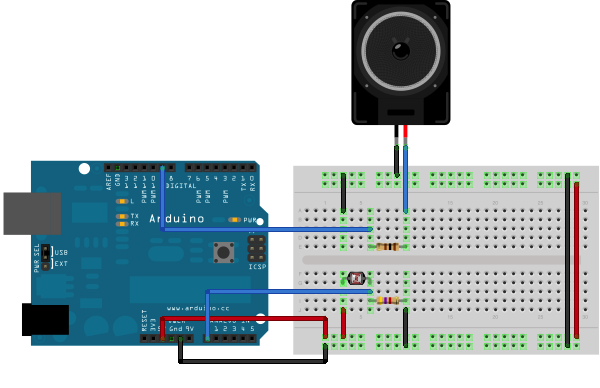Learning Examples | Foundations | Hacking | Links
Examples > Digital I/O
Pitch follower using the tone() function
This example shows how to use the tone() command to generate a pitch that follows the values of an analog input
Hardware Required
- 8-ohm speaker
- 1 photocell
- 4.7K ohm resistor
- 100 ohm resistor
- breadboard
- hook up wire
Circuit
image developed using Fritzing. For more circuit examples, see the Fritzing project page
Connect one terminal of your speaker to digital pin 9 through a 100 ohm resistor, and its other terminal to ground. Power your photoresistor with 5V, and connect it to analog 0 with the addition of a 4.7K resistor to ground.
Schematic
click the image to enlarge
Code
The code for this example is very simple. Just take an analog input and map its values to a range of audible pitches. Humans can hear from 20 - 20,000Hz, but 100 - 1000 usually works pretty well for this sketch.
You'll need to get the actual range of your analog input for the mapping. In the circuit shown, the analog input value ranged from about 400 to about 1000. Change the values in the map() comand to match the range for your sensor.
The sketch is as follows:
Pitch follower
Plays a pitch that changes based on a changing analog input
circuit:
* 8-ohm speaker on digital pin 8
* photoresistor on analog 0 to 5V
* 4.7K resistor on analog 0 to ground
created 21 Jan 2010
modified 30 Aug 2011
by Tom Igoe
This example code is in the public domain.
http://arduino.cc/en/Tutorial/Tone2
*/
void setup() {
// initialize serial communications (for debugging only):
Serial.begin(9600);
}
void loop() {
// read the sensor:
int sensorReading = analogRead(A0);
// print the sensor reading so you know its range
Serial.println(sensorReading);
// map the pitch to the range of the analog input.
// change the minimum and maximum input numbers below
// depending on the range your sensor's giving:
int thisPitch = map(sensorReading, 400, 1000, 100, 1000);
// play the pitch:
tone(9, thisPitch, 10);
}

